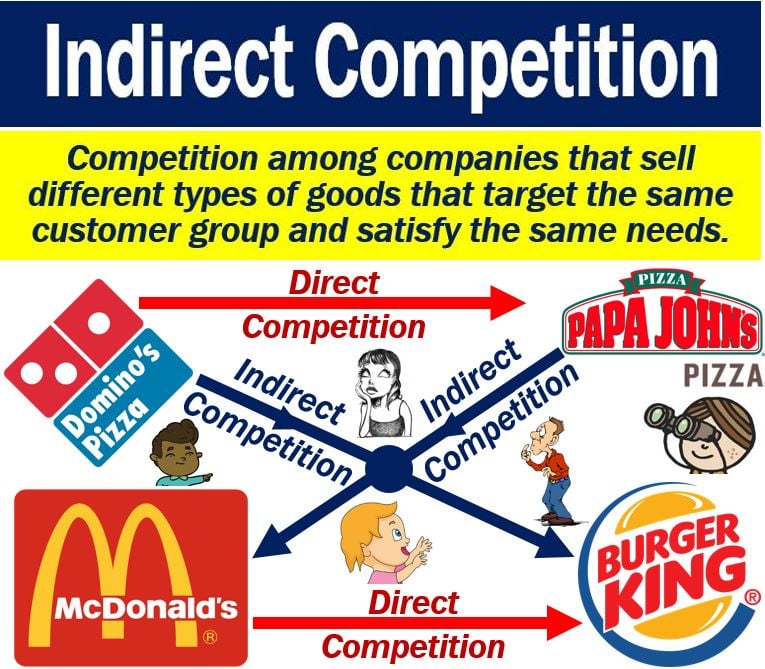Indirect competition is competition between companies that make slightly different products but target the same customers. We can also use the term for providers of services. Apart from targeting the same group of customers, they also aim to satisfy the same needs.
A hamburger fast food restaurant is in indirect competition with a fast food pizza restaurant. However, it is in direct competition with other hamburger fast food restaurants.
Both hamburger and pizza are targeting the same group of customers, i.e., hungry people. Specifically, their target customers are hungry and want a cheap and filling meal. These customers have something else in common too. They do not want to wait long after placing their order. That is why we call them fast food restaurants.
Direct and indirect competitors
In an indirect competition situation, the two competing businesses are indirect competitors. They contrast with direct competitors, who not only target the same customer group, but also sell the same thing.
Pizza Hut and Domino’s Pizza, for example, both sell pizzas. Therefore, they are direct competitors.
Domino’s and McDonald’s sell pizzas and hamburgers respectively. However, they both target hungry customers who want quick service and a cheap price. Therefore they are indirect competitors.
When using the term ‘indirect competition,’ we could be talking about the products or product providers. In other words, we could be talking about the two restaurants or hamburgers versus pizzas.
Monash University’s Marketing Dictionary says the following regarding the term:
“A product that is in a different category altogether but which is seen as an alternative purchase choice; for example, coffee and mineral water are indirect competitors.”

Indirect competition and substitute goods
Many sellers of substitute goods and sellers of substitute goods are in indirect competition.
Substitute goods are at least two products that we could use for the same purpose, i.e., to satisfy the same need.
Pepsi-Cola and Fanta, hamburgers and cheeseburgers, pizzas and fried chicken, are substitute goods. If we cannot get our first choice, the alternative usually satisfies that need.
If I want a cold Pepsi because I am hot and thirsty, I will take a cold Fanta if there is no Pepsi available. I will accept it because the Fanta also cools me down and quenches my thirst. The two products are in indirect competition, i.e., they are substitute goods.
Other examples of substitute goods, i.e., goods in indirect competition are:
- Kindle and paperback books.
- Tea and coffee.
- Aspirin, ibuprofen, and Tylenol (UK: paracetamol).
- Butter and margarine.
- Cars and motorbikes, and to some extent cars and bicycles.
- Bananas and other fruit.
Perfect substitute and close substitute goods
There are two types of substitute goods:
– Perfect substitute goods: the two products are virtually the same, except for their brand names. For example, Pepsi-Cola and Coca-Cola are perfect substitute goods.
– Close substitute goods: the two products are slightly different, but they target the same group of customers and satisfy the same needs. For example, Pepsi-Cola and Fanta are close substitute goods.
Therefore, close substitute goods are in indirect competition, while perfect substitute goods are in indirect competition.
